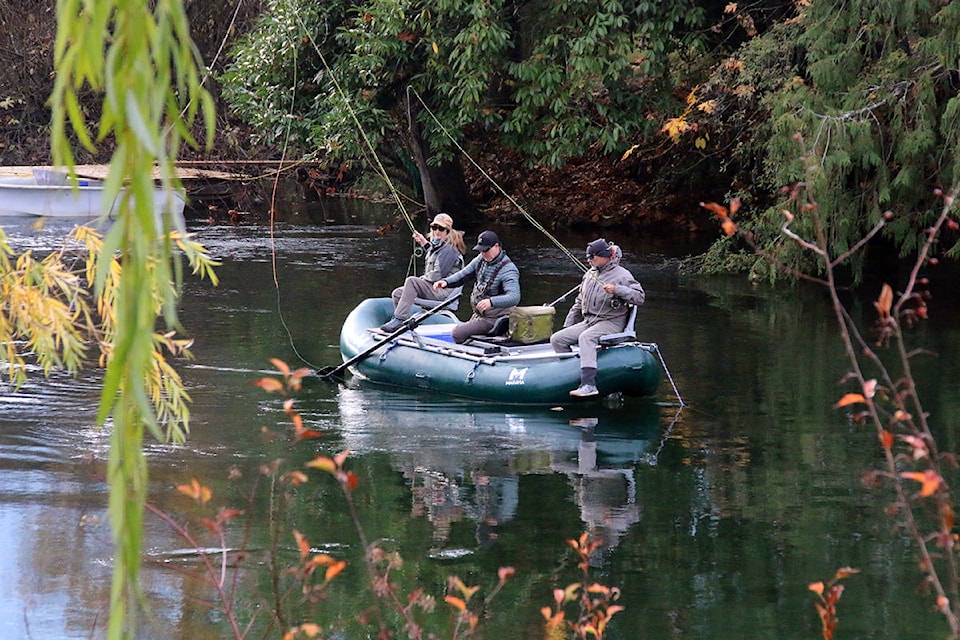For the past 10 years or so now, I have been concentrating much, if not most, of my stillwater fishing efforts on a number of smaller lakes located right here in the Southern Interior.
I have chosen these lakes not so much because of the size of fish that inhabit their waters, but more because each lake represents a whole plethora of different types of fishing opportunities.
One of my favourite lakes to fish is actually a group of small interconnected lakes know as the Dee Lake chain.
Dee Lake itself is a shallow little lake with fallen trees lining almost the entire shoreline. Island Lake, named because of the island at the far end just before the channel that leads into Crooked Lake, has two distinctly different weed beds on either side of the island that are inhabited by a multitude of sub-aquatic insects.
Crooked Lake is little more than a wide channel that connects Island with Deer Lake, although fish regularly travel back and forth between the two lakes.
Rising out of the dark stained waters of Crooked Lake are a fair number of deadfalls that make it both dangerous and rewarding to fish when the sun has gone down—when the fish are most actively feeding.
The waters of Deer Lake are so clear that a bad cast and/or too many false casts will most certainly spook the fish.
Over the years I have made a concerted effort to figure out (and remember) how to read the waters of each of these lake.
What I have learned from fishing these lakes I have been able to apply to many other lakes that are similar in size and structure.
Read More: Column: Province provides great ice-fishing opportunities
Read More: B.C. First Nations get clarity on fishing rights from top court
Attaining an understanding or ‘ability to read the waters’ of pretty well any interior lake is achieved, in part, by making observations and remembering/recording your observations so that you have an idea where the fish might be on subsequent trips.
Ultimately, it is the ability to make a calculated guess as to where the fish might be—and what they are most likely to be feeding on.
Although fish are relatively opportunistic feeders, I have found that they can also be quite selective.
Fish are, by their very nature, relatively wary creatures. If you want to catch fish you have to think like a fish.
So look for areas where there is natural protective cover for both insects and fish, and you will likely find a number of fish hanging around in search of a meal.
Remember, it’s only when fish feel safe and secure enough to venture out from their protective cover in search of something to eat that they will go after your artificial offering—and only if it is similar in shape and size to the natural.
Now I know there are all sorts of very successful anglers out there who are very diligent about gathering all sorts of information about when certain insect hatches come off and the migration patterns of fish feeding within a given body of water.
I also know that if you save such information in a fishing journal, it can pay huge dividends. Having said that I’ve tried recording such information and I’m more than happy when I come across any sort of notation scribbled down on a piece of paper in my tackle box, especially when I can read my own handwriting and figure out what it says.
For what’s it’s worth, I’m the sort of angler that prefers to make mental notes and simply store them in my head. And yes, before anyone can say anything, I will be the first to admit that I have had only limited success with this technique.
Read More: Column: Waiting for return of fishing season
Read More: Passion for fishing leads to fines
All I know for sure is that if fish appear to be rising to some sort of small pale greenish-brown coloured insect with mottled wings lying flat along its back, I don’t really care if it’s a caddis fly or a horsefly, as long as I can match the natural with one of the fly patterns in my fly box.
I guess when it comes right down to it, knowing how to read the waters is as much about taking the time to make the observations as it is about recording them, whether by writing the information down or storing it at the back of your mind.
To me it doesn’t really matter as long as I know I am in the right spot.
@SalmonArm
newsroom@saobserver.net
Like us on Facebook and follow us on Twitter
